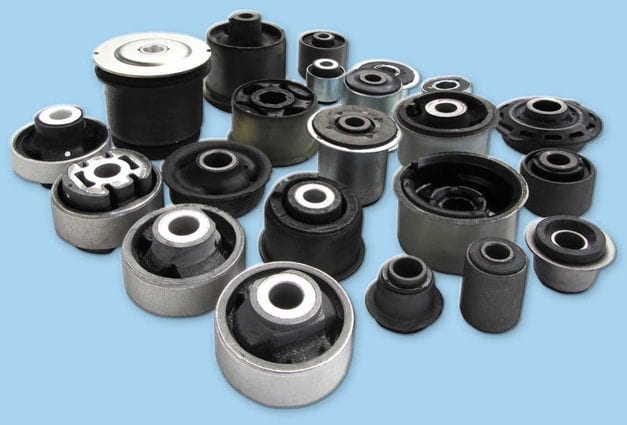
Что такое сайлентблок и когда его меняют
Содержание
- Что такое сайлентблок и его назначение
- Где располагаются сайлентблоки?
- Виды и типы сайлентблоков
- Как проверить сайлентблоки?
- Как правильно поменять сайлентблоки
- Какие сайлентблоки лучше: полиуретановые или резиновые?
- Причины выхода из строя и что ломается в сайлентблоке
- Видео: «Типы и замена сайлентблоков»
- Вопросы и ответы:
Сайлентблоки (далее “с/б”) — это деталь подвески, представляющая собой две металлические втулки, между которыми расположена резиновая вставка. Сайлентблок соединяет между собой детали подвески, гасит колебания между узлами. Сайлентблоки способствуют комфортной езде за счет упругости резины, которая служит демпфером между деталями подвески.
Что такое сайлентблок и его назначение
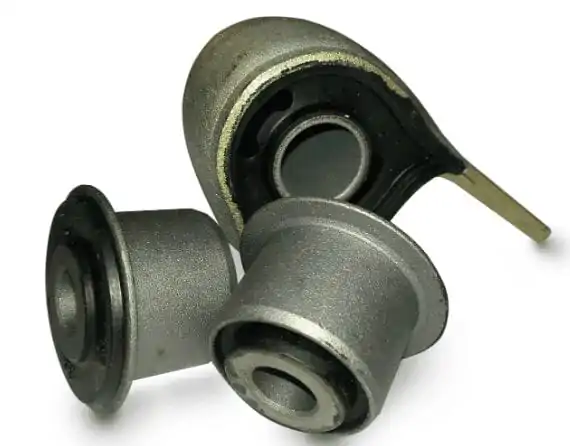
Сайлентблоки работают на избежание деформации деталей подвесок и кузова. Они первые принимают удары и колебания, после чего их гасят амортизаторы. Также сайлентблоки делятся на следующие категории:
- конструкция (с одной, двумя втулками или без металлических элементов);
- расчетная нагрузка (сплошная эластичная вставка или с отверстиями);
- тип крепления (втулки или корпус с проушинами);
- подвижность (средней подвижности и “плавающий”);
- материал (резина или полиуретан).
Конструктивно сайлентблоки отличаются между собой по форме, в зависимости от исполнения рычага. Чаще всего на треугольных рычагах передней подвески типа МакФерсон применяют две втулки — задние сайлентблоки с двумя втулками, передние с внутренней под болт, наружная обойма отсутствует. Кстати, задние с/б передней подвески могут быть гидронаполенными. Такая конструкция позволяет лучше поглощать энергию колебания, но как только жидкость начнет вытекать — эффективность сайлентблоков резко снижается.
По расчетной нагрузке лучше применять сплошные с/б, их ресурс значительно выше.
По подвижности отдельного внимания стоят “плавающие” сайлентблоки. Они применяются в задней многорычажной подвеске, могут выпрессовывается в поворотный кулак или поперечную штангу. У “плавающей” втулки есть вторая задача — дать колесу свободно поворачиваться на определенный угол, при этом оставаясь неподвижным в вертикальной и горизонтальной плоскости. Изделие представляет собой обйому, с двух сторону закрытую пыльником, внутри которой установлен шарнир.За счет движения шарнира задняя подвеска “подруливает” когда нужно, автомобиль на дороге за счет этого более устойчивой на крутых поворотах.. Главным недостатком “плавающей” втулки является то, что резиновый пыльник слишком уязвим к агрессивной среде, после пропускает пыль и влагу, резко снижая ресурс детали.
Где располагаются сайлентблоки?
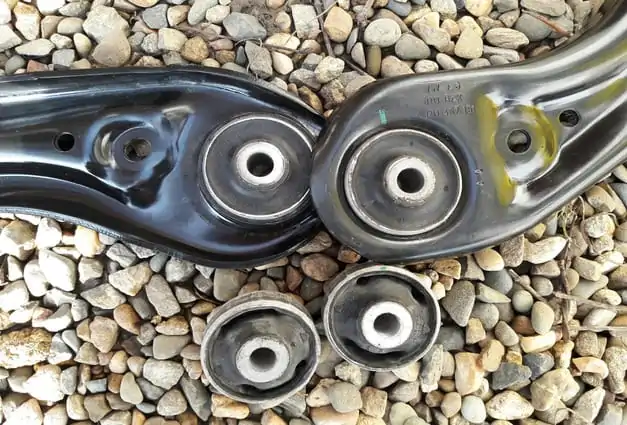
Резино-металлические втулки применяются в следующих деталях подвески:
- передние и задние рычаги;
- продольные и поперечные тяги задней подвески;
- в качестве втулок стабилизатора;
- в поворотных кулаках;
- в амортизаторах;
- в качестве крепления силового агрегата и трансмиссии;
- на подрамниках.
Использование полноценных сайлентблоков вместо резиновых втулок значительно улучшило технические характеристики ходовой части за счет того, что резина в жесткой втулке лучше работает на скручивание, эффективнее гасит колебания и не так быстро изнашивается.
Виды и типы сайлентблоков
Существует две категории, по которым классифицируются все сайлентблоки:
- По материалу, из которого они изготавливаются;
- По типу (форма и конструкция).
Сайлентблоки задней балки и передних рычагов изготавливаются из резины или полиуретана.
По типу различают:
- Стандартный неразборный. Такие детали имеют металлическую обойму с резиновой вставкой внутри. Существуют также модификации с одной металлической вставкой. В этом случае она будет помещена внутри резиновой основы.
- Перфорированный сайлентблок или с полостями в резиновой части. Такие сайлентблоки обеспечивают плавное скручивание рычага. Запрессовка детали должна производиться равномерно, чтобы нагрузка распределялась по всей рабочей части элемента.
- Сайлентблок с ассиметричными проушинами. В таких деталях нет сквозного крепежного отверстия. Вместо него используются проушины. Такая конструкция позволяет фиксировать детали, находящиеся в смещенных плоскостях относительно друг друга.
- Плавающая конструкция. Внешне плавающие сайлентблоки похожи на шаровые опоры. Чтобы в процессе эксплуатации резиновая часть не изнашивалась, она прикрыта пыльником из резины. Такая модификация обеспечивает плавное движение установленной на ней детали. Могут использоваться для рычагов, но чаще их устанавливают в поворотных кулаках ступицы.
Как проверить сайлентблоки?
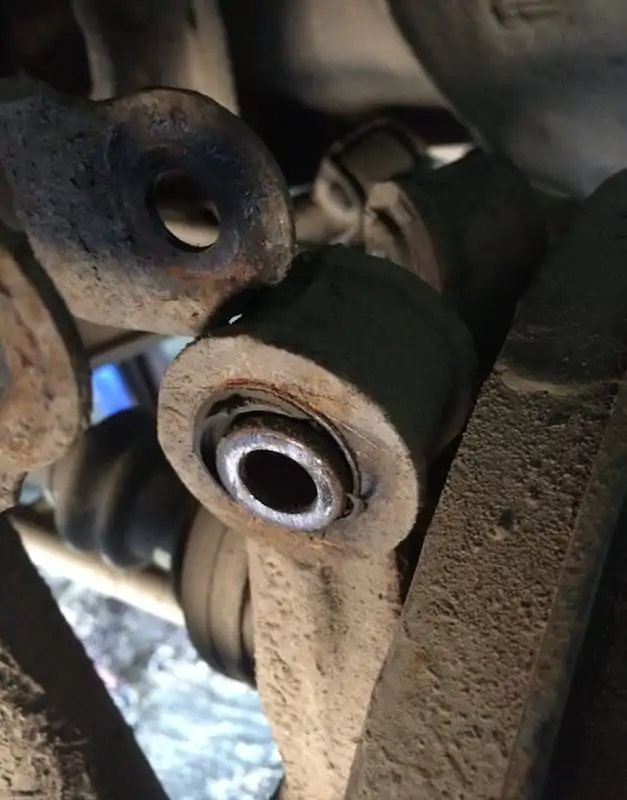
Средний ресурс резино-металлических деталей подвески — 100 000 км. Диагностика с/б проводится каждые 50 000 км. Для этого потребуется поднять автомобиль на подъемнике. Первичный осмотр зрительный, требуется выявить наличие трещин или разрывов резины. Если имеются трещины, то это признак того, что скоро с/б потребуется заменить.
Далее проверка производится при помощи монтировки. Уперевшись в рычаг имитируем его работу, при это ход рычага должен быть тугой. Также это касается и подушек крепления двигателя, втулок амортизаторов.
На ходу об износе сайлентблоков говорит сильный стук на неровностях, “расхлябанность” подвески.
Когда меняют
Замена сайлентблоков производится только при явном износе, в других случаях их трогать не имеет смысла. Категорически рекомендуется менять резино-металлическую деталь с двух сторон, потому как на ходу подвеска начинает проявлять себя неадекватно из-за разности работы рычагов.
Кстати, не каждая подвеска начинает “звучать” при износе с/б. Например: автомобиль Mercedes-Benz W210 и BMW 7-series E38 до последнего сохраняют “тишину”, даже когда сайлентблоки полностью порваны. Это говорит о том, что диагностика ходовой части должна осуществлять по пробегу и по первым признакам неадекватного поведения подвески.
Срок эксплуатации
Обычно ресурс оригинальных компонентов достигает 100 000 км и более, в зависимости от того, где эксплуатируется авто. Говоря об аналогах, то самые дешевые варианты могут выйти из строя уже на второй тысяче километров. Нормальный пробег хорошего аналога составляет 50-80% от ресурса оригинальной запчасти.

Как правильно поменять сайлентблоки
Сложность процедуры замены сайлентблоков зависит от модели автомобиля, точнее от типа подвески авто. Но даже в самом простом исполнении сайлентблоки не всегда легко и заменить.
Вот пошаговая инструкция последовательности выполнения этой работы:
- Подобрать подходящие инструменты. Чтобы вывесить автомобиль, потребуется домкрат (если его еще нет в инструментарии автомобилиста, то в отдельной статье подробно рассказывается, как его подобрать для своей машины). Также понадобится стандартный набор гаечных ключей. Чтобы проще было грамотно установить сайлентблоки, лучше приобрести на рынке инструмент для их запрессовки. Помимо этого потребуется специальный съемник для шаровых опор.
- Поднимается одна сторона автомобиля и снимается вывешенное колесо.
- Откручивается и снимается гайка сверху шаровой опоры.
- Откручивается рычаг подвески.
- Выпрессовывается сайлентблок и запрессовывается новый.
- Монтируется рычаг. Добавляется смазка, чтобы соединение не изнашивалось быстрее.
- Та же процедура проводится с нижним рычагом.
- Наживляется колесо, и затягивается уже на земле.
Если в машине задняя часть подвески оснащена сайлентблоками, то их замена производится в похожей последовательности:
- Вывешивается задняя часть машины.
- Проверяется состояние сайлентблоков и наличие люфта в рычагах.
- Задние сайлентблоки меняются, если есть люфты в рычагах или резиновая часть деталей явно износилась (имеются деформации или трещины).
В остальном сайлентблоки на задней оси меняются тем же образом, что и спереди. Колеса зажимаются, когда машина уже опущена на землю, чтобы транспортное средство не соскользнуло с домкрата.
При замене сайлентблоков всегда нарушается геометрия подвески, так как откручиваются рычаги и шаровые опоры. По этой причине после выполнения ремонтных работ обязательно необходимо выполнить регулировку развала-схождения. Здесь подробно описывается важность данной процедуры.
Какие сайлентблоки лучше: полиуретановые или резиновые?
Однозначно при выходе из строя сайлентблока разумным решением будет замена на идентичный, который предусмотрел производитель. Если водитель незнаком с устройством своего автомобиля, то подбор сайлентблоков можно осуществить по каталогу для конкретной машины.
Прежде чем производить замену сайлентблоков автовладельцу следует определиться с материалом, из которого изготовлена деталь.
На современном рынке автозапчастей покупателю предлагается два варианта: резиновые и полиуретановые аналоги. Вот в чем их разница.
Резиновые сайлентблоки
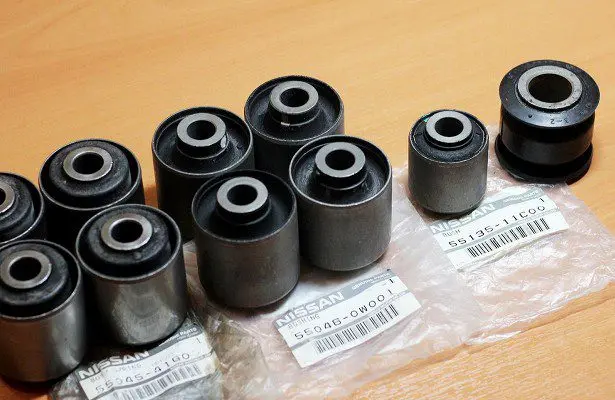
В основе таких сайлентблоков используется каучук. Эти детали дешевые и их легче найти в магазинах. Но такой вариант имеет несколько существенных недостатков:
- Небольшой рабочий ресурс;
- Скрипят, даже после замены;
- Плохо переносят агрессивное воздействие окружающей среды, например, резина растрескивается при нагрузках на сильном морозе.
Полиуретановые сайлентблоки

Самый существенный недостаток полиуретановых сайлентблоков по сравнению с предыдущим вариантом – высокая стоимость. Однако этот фактор перекрывается наличием многих преимуществ:
- Бесшумная работа;
- Поведение автомобиля на дороге становится мягче;
- Точка опоры чрезмерно не деформируется;
- Увеличенный рабочий ресурс (иногда до 5 раз, если сравнивать с резиновым аналогом);
- Лучше гасит вибрации;
- Улучшает управляемость автомобиля.
Причины выхода из строя и что ломается в сайлентблоке
В основном на ресурс любой детали автомобиля влияет не только ее качество, но также условия эксплуатации. Бывает так, что качественный сайлентблок не вырабатывает свой ресурс в автомобиле, который постоянно ездит по ухабистой дороге.
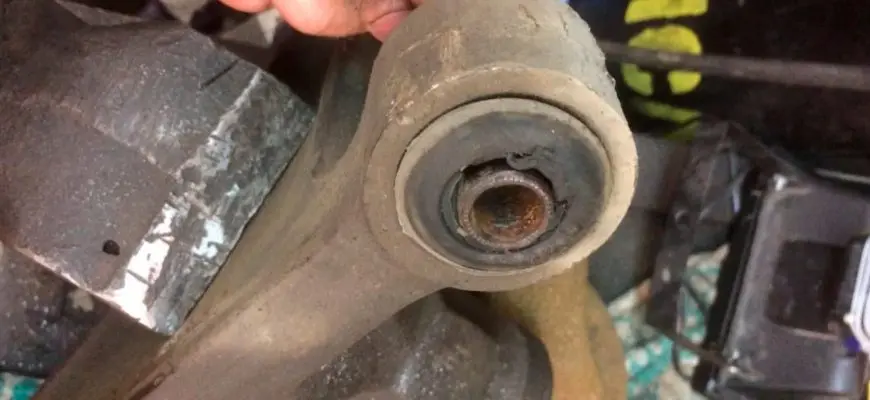
В другом случае машина эксплуатируется в большей степени в городе, а водитель аккуратно и размеренно водит. В таких ситуациях даже бюджетный сайлентблок может отходить приличный ресурс.
Основная поломка сайлентблоков – разрыв или деформация резиновой части, потому что она является демпфером точки опоры. В некоторых узлах на нее воздействуют силы скручивания. Поломка металлической обоймы происходит очень редко. Основной причиной этому является нарушение процедуры запрессовки.
Резиновая часть преждевременно изнашивается в таких случаях:
- Нарушение технологии замены сайлентблоков. Когда затягиваются крепежные болты, автомобиль должен уверенно стоять на колесах, а не быть поддомкраченным. В противном случае неправильно затянутая деталь после того, как машина будет опущена на землю, подвергнется скручиванию. Впоследствии резина под дополнительной нагрузкой порвется.
- Нарушение процесса запрессовки. Если деталь будет установлена со смещением, в процессе эксплуатации нагрузка не будет распределяться равномерно.
- Естественный износ. Некоторые водители уделяют внимание сайлентблокам только тогда, когда с ними возникла проблема, часто превышая рекомендованный срок эксплуатации.
- Агрессивное воздействие химических веществ. К этой причине относятся реагенты, которыми посыпается дорога. Обычное машинное масло тоже с легкостью разрушает резину.
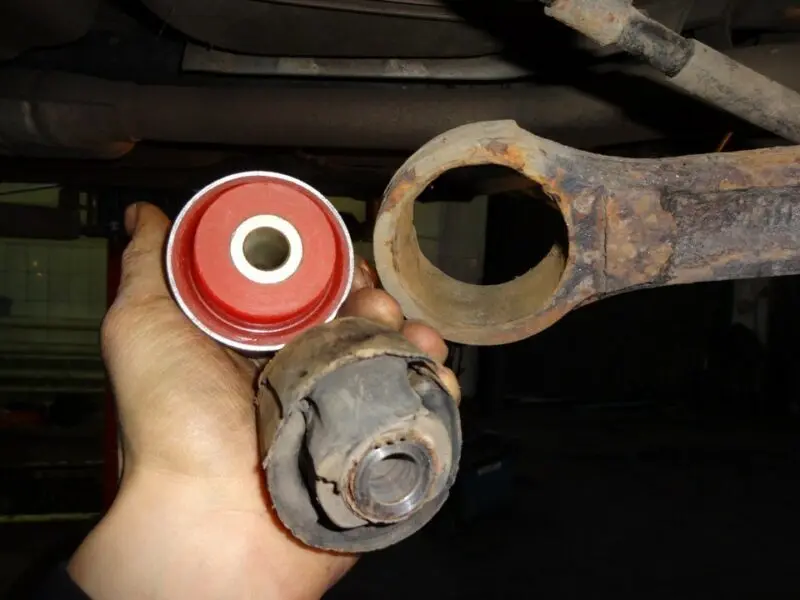
Вот по каким признакам можно определить, что сайлентблоки необходимо заменить:
- Автомобиль проехал почти 100 000 километров (если дорожные условия были плохого качества, то интервал замены уменьшается – приблизительно через 50-60 тысяч);
- Появился люфт, автомобиль становится неустойчивым и менее комфортным в управлении;
- Рисунок протектора шин неравномерно изнашивается (при этом нужно учесть, что это может быть следствием других неисправностей, о которых рассказывается в отдельной статье);
- Крепления рычагов повреждены.
Проводя своевременное и качественное обслуживание автомобиля, владелец машины избежит ненужных растрат на ремонт деталей, которым еще не пришел срок.
Видео: «Типы и замена сайлентблоков»
В данном видео рассматриваются разные типы сайлентблоков и последовательность их замены:
Вопросы и ответы:
Что будет если не менять сайлент блоки? Из-за разорвавшегося сайлентблока рычаг подвески становится криво. Из-за увеличившегося люфта разбивается посадочное место крепления шарнира, что приведет к поломке всего рычага.
Что делает сайлентблок? В первую очередь эти элементы соединяют детали подвески автомобиля. Во время движения между этими деталями возникают колебания. Сайлентблок смягчает эти вибрации.
Почему называется сайлентблок? От английского silent block – тихий узел. Это неразборный элемент с двумя втулками, соединенными между собой при помощи вулканизации.
Для чего нужны сайлентблоки передних рычагов? Так как в конструкции сайлентблока присутствует мягкий материал (резина или силикон), то, соединяя детали подвески, он гасит вибрации и удары, возникающие в рычагах.

